Contents
- 1. manual1
- 2. manual2
manual2

F-07C_EN_ninshou
17
Introduction
・
Do not use FOMA terminal with the back cover removed.
- May cause the battery to come off, or may cause a
malfunction or damage.
・
Do not put extreme thick sticker on the keypad face.
- May cause malfunction, damage or erroneous
operation.
・
Do not put label, sticker, etc. on the back side of display.
-
Label, sticker, etc. may be hooked when opening/closing
FOMA terminal and may cause malfunction or damage.
・
While microSD card is being used, do not take the
card out and do not turn OFF FOMA terminal.
- May cause data loss or malfunction.
・
Do not bring magnetic cards etc. close to FOMA
terminal nor clip it by FOMA terminal.
- Magnetic data in cash cards, credit cards, telephone
cards, floppy disks, etc. may be erased.
・
Do not bring magnetized objects close to FOMA terminal.
- Bringing strong magnetism close may cause a
malfunction.
・
The battery pack is a consumable part.
- Replace the battery pack if FOMA terminal has
extremely short operation time on a full charge,
though it may vary by operating conditions. Purchase
a new battery pack of the specified type.
・
Charge the battery in an area within the proper
ambient temperature range (5-35
℃
).
・
The operation time provided by the battery pack
varies by the operating environment and battery
pack's deterioration.
・
The battery pack may swell out as it comes to near the
end of its lifetime depending on the usage conditions,
but it is not a problem.
・
Be careful especially about the following points when
preserving the battery pack.
- Keeping under the state of the full charge (right after
charging ends)
- Keeping under the state of the empty charge (too
exhausted to turn on FOMA terminal)
They may cause the battery pack performance to be
degraded or its lifetime to be shortened.
A recommended battery level to keep the battery pack
is the battery icon in 2 cells or in 40 % of remaining
battery level as a guide.
・
Charge the battery in an area within the proper
ambient temperature range (5-35
℃
).
・
Do not charge the battery in the areas below.
- In areas of excessive humidity, dust or vibrations
- Near land-line phones or TVs/radios
・
It is normal for the adapter to become hot while
charging. Continue to use it.
・
When using an outlet with a mechanism preventing
unplugging, follow the handling instructions for that
outlet.
・
Do not give strong shock. Do not deform the charging
jack.
- May cause malfunction.
・
Do not use excessive force to install/remove UIM.
・
Note that DOCOMO assumes no responsibility for
malfunctions occurring as the result of inserting and
using UIM with another IC card reader/writer.
・
Always keep UIM ICs clean.
・
Clean UIM with a soft, dry cloth (such as a cloth for
eyeglasses).
・
Maintain a separate record of the data you saved in
UIM.
- If the data is deleted, DOCOMO assumes no
responsibility for the loss of any data.
・
To preserve the environment, bring the old UIM to a
sales outlet such as docomo Shop.
・
Take care not to scratch, touch accidentally or short
IC.
- May cause data loss or malfunction.
・
Do not drop UIM or subject it to shocks.
- May cause malfunction.
・
Do not bend UIM or place heavy objects on it.
- May cause malfunction.
・
Do not install UIM into FOMA terminal with a label or
sticker put on.
- May cause malfunction.
Battery pack
Adapter
UIM
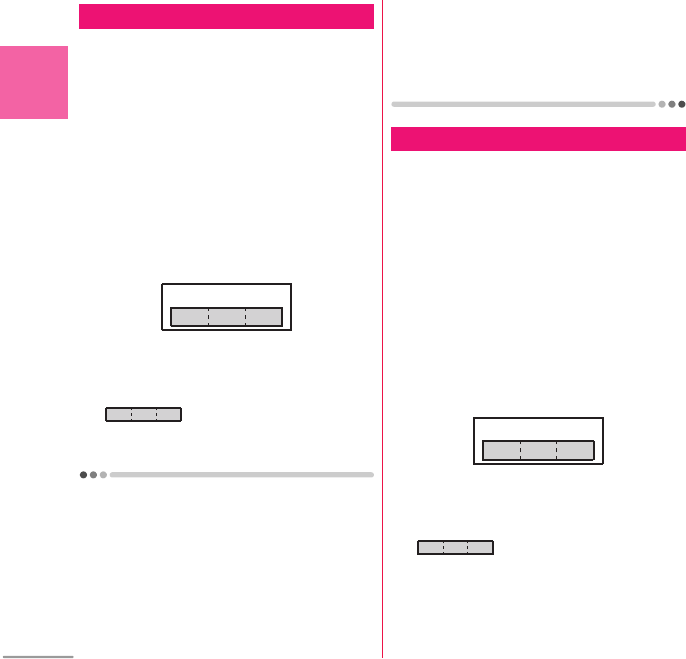
F-07C_EN_ninshou
18
Introduction
・
This FOMA terminal is equipped with the security
features, that are compliant with Bluetooth standards
for communication via Bluetooth. However,
depending on the settings, there may not be enough
security. Be aware of security risks when using
Bluetooth.
・
DOCOMO assumes no responsibility for any
information which may be leaked during
communication via Bluetooth.
・
You can use headset, handsfree and audio devices
with FOMA terminal. An audio/video remote control
may be available with an audio device (only Bluetooth
compatible devices).
・
Frequency bands
Frequency bands used by FOMA terminal Bluetooth
function are as below.
a
2.4 : Radio equipment that uses the 2400 MHz band.
b
FH : The modulation is the FH-SS method.
c
1 : The expected interference distance is 10 m or
shorter.
d
: All bandwidths between 2400 MHz
and 2483.5 MHz are used, and the bandwidth used by
mobile object identification devices cannot be
avoided.
Cautions on using Bluetooth devices
In the bandwidth used by this terminal, in addition to
home electric appliances such as a microwave oven and
industrial/scientific/medical devices, in-plant radio
stations used to identify mobile objects used in
production lines of a factory that require a license,
specified low power radio stations, or amateur radio
stations that do not require a license (hereafter "other
radio stations") can be in operation.
1. Before using this terminal, check whether other radio
stations are in operation in your neighborhood.
2. If radio wave interference occurs between the
terminal and "other radio stations", use the terminal
in a different location or "Turn the power OFF" to
avoid the radio wave interference.
3. For more detailed information, contact the numbers
for "General Inquiries" on the last page of this
manual.
・
Wireless LAN
Do not use Wireless LAN in a place where magnetized
by electric products, AV, OA equipment, etc. or where
electromagnetic wave is generated.
- If magnetism or electrostatic noise affects FOMA
terminal, noise may be increased or communication
may not be available (especially when using
microwave oven, it may affect the terminal).
- Using near TV or radio may cause poor reception or TV
screen may be blurred.
- When multiple wireless LAN access points exist near
FOMA terminal and they use the same channel, search
may not be performed correctly.
・
Frequency bands
Frequency bands for WLAN devices are written on
battery pack insert section of phone. Label description
are as follows.
a
2.4 : Radio equipment that uses the 2400 MHz band.
b
DS : The modulation is the DS-SS method.
c
OF : The modulation is the OFDM method.
d
4 : The expected interference distance is 40 m or shorter.
e
: All bandwidths between 2400 MHz
and 2483.5 MHz are used, and the bandwidth used by
mobile object identification devices can be avoided.
Available channel varies by countries. To use WLAN
overseas, check the conditions such as available
frequency, regulation, etc. for the country.
To use in airplane, confirm with airline company in
advance.
Bluetooth devices
ab
d
c
2.4FH1
Wireless LAN (WLAN)
ab
d
c
2.4FH1

F-07C_EN_ninshou
19
Introduction
Cautions on using 2.4GHz devices
In the bandwidth used by WLAN devices, in addition to
home electric appliances such as a microwave oven and
industrial/scientific/medical devices, in-plant radio
stations for identification of mobile objects used in
production lines of a factory (a license is required),
specified low power radio stations (a license is not
required), or amateur radio stations (a license is
required) can be in operation.
1. Before using this device, confirm that in-plant radio
stations for identification of mobile objects, specified
low power radio stations or amateur radio stations
are not in operation in your neighborhood.
2. If this device generates harmful radio wave
interference against in-plant radio stations for
identification of mobile objects, change the using
frequency promptly or stop using wireless LAN
function, and contact "General Inquiries" on the last
page of this manual, then consult about treatment for
prevention of the interference (for example,
installation of partitions etc.).
3. If this device generates harmful radio wave
interference against in-plant radio stations for
identification of mobile objects or amateur radio
stations, or if any trouble, contact "General Inquiries"
on the last page of this manual.
・
FeliCa reader/writer function of FOMA terminal uses
weak waves requiring no licenses for radio stations.
・
It uses 13.56 MHz frequency band. When using other
reader/writers in your surroundings, keep FOMA
terminal away sufficiently from them. Before using
the FeliCa reader/writer, confirm that there are no
radio stations using the same frequency band nearby.
・
Do not use a remodeled FOMA terminal. Using a
remodeled terminal violates the Radio Law.
FOMA terminal is certified according to technical
standard conformance of specified wireless
equipment based on the Radio Law, and as a proof of
it, the "Technical Compliance Mark " is depicted on
the nameplate sticker of FOMA terminal.
If you remodel FOMA terminal by removing its screws,
your certification of technical standard conformance
becomes invalid.
Do not use FOMA terminal with its certification of
technical standard conformance invalid as it violates
the Radio Law.
・
Be careful when you use FOMA terminal while driving
a car etc.
Using a mobile phone while driving is subject to penal
regulations.
However, absolutely necessary cases such as rescue
of a sick person or maintaining public's safety are
exempted.
・
Use the Bluetooth function only in Japan.
The Bluetooth function of the FOMA terminal is
compliant with wireless standards and is authorized
for use only in Japan.
If you use this function overseas, you may be
punished.
・
Use the Wireless LAN (WLAN) function only in Japan.
The Wireless LAN function of FOMA terminal is
compliant with wireless standards and is authorized
for use only in Japan.
If you use this function overseas, you may be
punished.
・
Use FeliCa reader/writer function only in Japan.
FeliCa reader/writer function of FOMA terminal
conforms to Japanese radio standards.
If you use this function overseas, you may be
punished.
FeliCa reader/writer
CAUTION
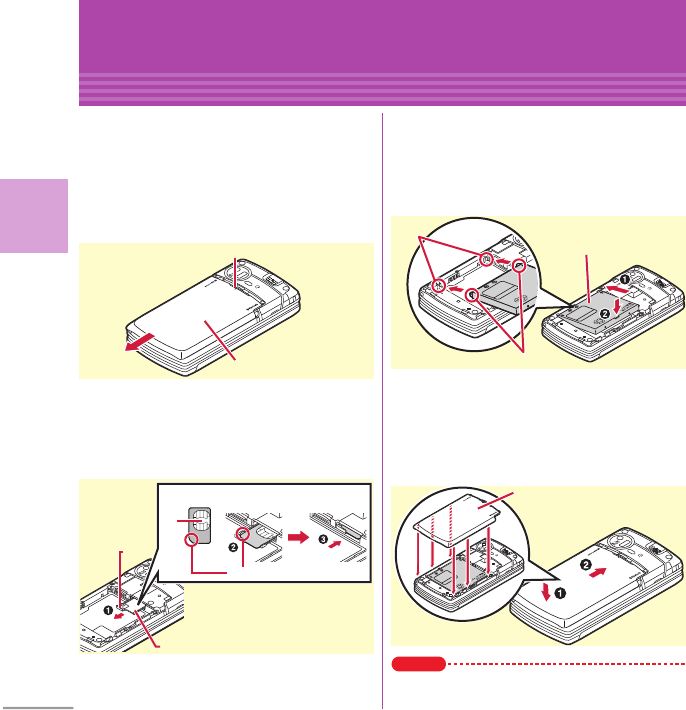
F-07C_EN_ninshou
20
Basic Operation
Before Using
Attaching UIM/battery pack
Turn the power OFF, close and hold the FOMA
terminal in your hand to attach UIM/battery pack
properly.
✜
Removing back cover
With pressing the back cover with your thumb, slide
approximately 3 mm in the direction of the arrow to
remove it.
✜
Installing UIM
Pull the tab with your nail and pull out the tray until
it clicks (
a
). Hold UIM with the IC side up, align the
beveled corner with the tray (
b
) and push into the
tray until it stops (
c
).
✜
Attaching battery pack
With label side of the battery pack up, align convex
parts of the battery pack with concave parts of the
FOMA terminal, slide the battery pack in the
direction of
a
and then press it in the direction of
b
to set in.
✜
Attaching back cover
Place the 7 tabs of back cover to the notches of the
FOMA terminal, press the back cover in the
direction of
a
to avoid forming any clearance
between them, then slide it in the direction of
b
to
attach.
Point
・
UIM (blue) is not available for this FOMA terminal. If
you have the UIM (blue), bring it to a docomo Shop.
Press here with thumb
Back cover
IC
Corner cut
UIM
Tray
Tab
Battery pack
Concave
parts
Convex parts
Back cover
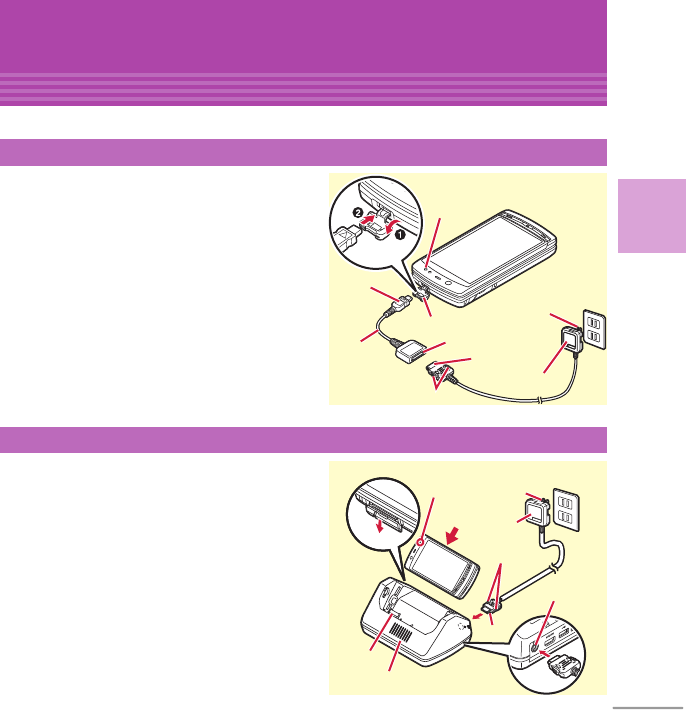
F-07C_EN_ninshou
21
Basic Operation
Before Using
Charging
The battery pack does not have a full charge at time of purchase. Charge the battery before using the FOMA terminal.
a
Insert the USB plug of USB cable
horizontally to the USB connection jack,
with the mark side upward
b
Open microUSB connection jack cap (
a
), hold
the connector horizontally with the mark side
upward and insert it to the jack (
b
)
c
Insert the AC adapter's power plug into a
100V AC outlet
*
Check that the charging light turns on.
*
After charging is over, pull out the power plug
from the outlet, and pull out microUSB plug from
FOMA terminal horizontally.
Prepare Cradle Set F01, AC Adapter for Cradle F01,
and AC Adapter Power Cable for Cradle F01.
a
Insert AC adapter's connection jack to cradle's
power jack (
a
), and power cable's connection
jack horizontally to AC adapter (
b
)
b
Insert the power cable's power plug into a
100V AC outlet
c
Close the FOMA terminal, and insert it to cradle
with cradle connection jack cap opened
*
Check that the charging light turns on.
*
After charging is over, remove the FOMA
terminal from cradle.
Charging using AC Adapter F04 and USB Cable F01
Using cradle for charging
AC 100V
outlet
Connector
Release buttons
Connector
Jack cap
Power plug
AC adapter
Light
microUSB
plug adapter
for FOMA
charging F01
microUSB
plug
AC adapter
AC 100V
outlet
Power plug
Connector
Release buttons
Light
Insert at back side
Cradle
Connection
jack
仮
仮

F-07C_EN_ninshou
22
Basic Operation
Before Using
Turning power ON - Configuring default setting
Initial setting is an operation when the FOMA
terminal is turned ON for the first time.
af
(2 sec. or more)
b
"Yes" or "No" on a confirmation screen
of enlarged menu setting
The screen shown to the right appears.
c
Set required items
e
"Complete"
If you exit without setting Change security
code and Request permit/deny, Initial setting
screen reappears when the power is turned
ON the next time.
d
On a confirmation screen of software
update function, "OK"
The stand-by display appears.
Point
・
If no operation is performed, the display light is
automatically turned off according to the settings in
Light time-out or eco mode setting. The display light
turns on again if there is any operation or incoming
call.
Turning power off : f
(2 sec. or more)
Changing initial settings : mehgeg
Changing screen display to English :
mehbfce
Select "English"
Set whether to notify your phone number (caller
ID) to the other party's terminal when making a
voice call. Caller ID notification is set to "ON" at the
time of subscription.
ameh
Settings & NWservices
eh
NW Services
e
c
Caller ID
ea
Caller ID
notification
ea
Activate/
Deactivate
ea
Notify or
b
Not notify
Point
・
If you hear an announcement of requesting caller ID
when making a call, set Caller ID notification or add
prefix "186" to the phone number to call again.
You can check your own phone number.
For details of checking/changing a mail address,
refer to "Mobile Phone User's Guide [i-mode]
FOMA version".
amee0
User information
User information screen appears.
Point
・
You can display User information also by pressing
1p
on stand-by display.
Editing user information :
On User information edit
screen, "Edit"
e
Authenticate
e
Edit
e
"Set"
Checking a phone number during a call :
Ndf
Caller ID notification
User information
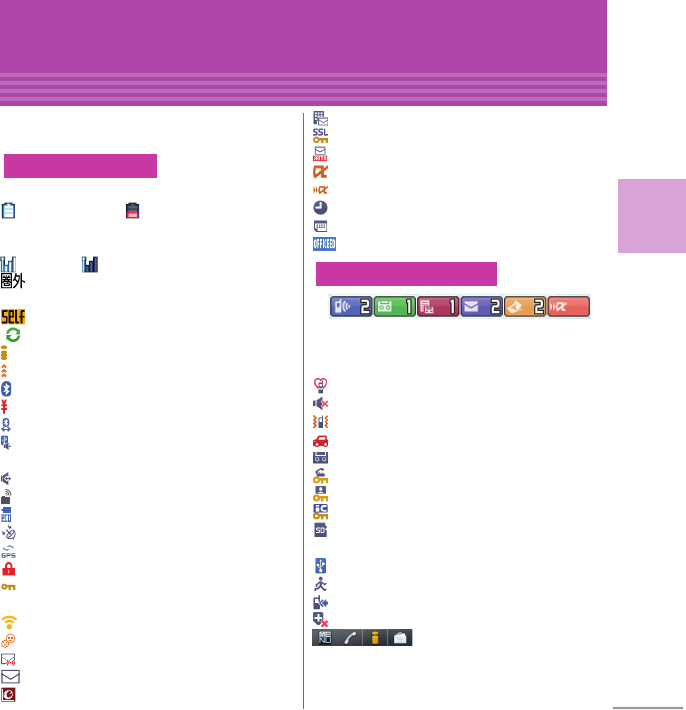
F-07C_EN_ninshou
23
Basic Operation
Screen Explanation
Viewing display
The current state can be checked by the icon
appearing on the display. Major icons are as follows.
Battery level (Battery icon)
(Ample charge)
⇔
(Almost exhausted
(Charge the battery))
Signal strength (Antenna icon)
(Strong)
⇔
(Weak)
: Out of service area or where radio waves do
not reach
:
Self mode ON
:
In data transfer mode
:
Connecting to i-mode
:
Infrared communication in operation
:
Bluetooth ON
:
The total calls cost exceeds the limit
:
Bluetooth connection being established
:
Communication using handsfree-compatible
device in progress
:
Handsfree ON
:
Femtocell setting available
:
eco mode activated
:
Positioning with GPS
:
Location request setting
:
Display off lock ON
:
A phonebook entry or schedule has secret
attribute
:
High-pitched alarm ON
:
Kid-safe mode ON
:
Unread Area Mail exists
:
Unread i-mode mail exists
:
Arrival i-concier information exists
:
Unreceived i-mode mail exists in i-mode Center
:
Displaying SSL/TLS page etc.
:
Auto-send mail exists
:
During i-
α
ppli operation
:
i-
α
ppli call received
:
Alarm clock ON
:
Schedule reminder ON
:
Inside OFFICEED area
Arrival information (Starting from the left, missed
call, recorded message, voice mail service, unread
message, unread ToruCa, i-
α
ppli call)
:
Silent mode ON
:
Call alert volume OFF
:
Vibrator for voice call ON
:
In Public mode (Drive mode)
:
Record message ON
:
Keypad dial lock ON
:
Personal data lock ON
:
IC card lock ON
:
microSD card installed during
Communication mode
:
Connected to external device using USB cable
:
Pedometer/ACT monitor is set
:
Software update rewrite notice
:
Auto-update of latest pattern definition failure
:
Stand-by touch buttons (Starting
from the left, display the menu, display the
outgoing call screen, display the mail menu,
display iMENU by connecting to i-mode)
Top of the display
Bottom of the display
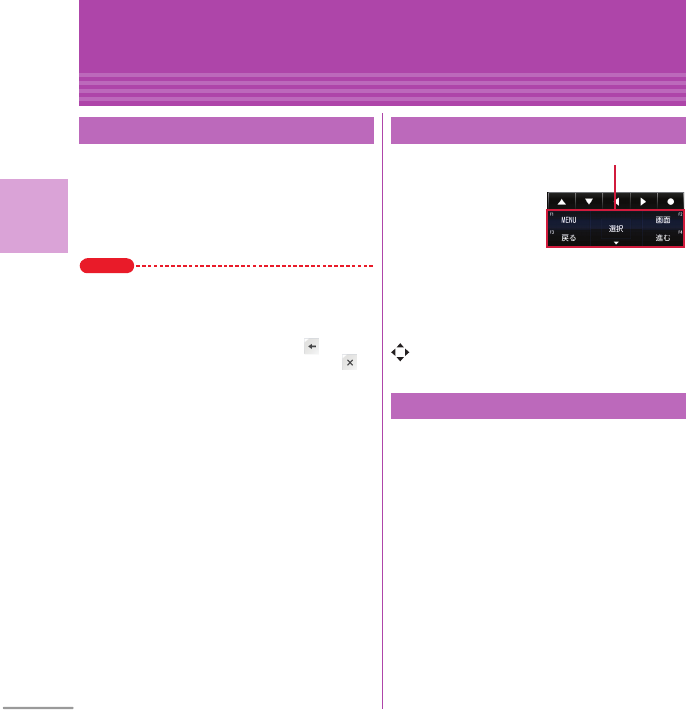
F-07C_EN_ninshou
24
Basic Operation
Screen Explanation
Basic operation of screens and keys
Touch
m
and then perform the functions from
the menu.
<Example>
Selecting "Calculator"
ame
Touch "
g
Accessory"
e
Touch
"
d
Calculator"
Point
・
For key operation, press
1ur
in slide style.
・
Even when a function is running, you can perform
the same operation if "MENU" is displayed on the
guide area.
・
To return to the previous screen, touch or press
c
. To return to the stand-by display, touch or
press
f
.
・
On the stand-by display with Info/calendar layout set,
or with arrival information icon or i-concier
information displayed, press
[
to change the
display to Focus mode that allows you to quickly
display the related information.
Operations that can
be performed by
touching the screen
or pressing
1
,
2
,
[
,
3
and
4
are
displayed in the
guide area. The
corresponding key appears at upper-right or
upper-left of each operation. To perform an
operation, press
1
,
2
,
3
or
4
. To perform an
operation in the center, press
[
.
on the guide area corresponds to arrow keys
U
,
D
,
L
and
R
.
You can switch among "Kisekae menu", the
design of which can be changed using Kisekae
Tool, "Basic menu", which has the fixed menu
numbers, and "Custom menu", to which menu
items can be saved freely.
To switch the menu screen, touch "Custom"/
"Basic" on Kisekae menu, or touch "Kisekae" on
Basic menu or Custom menu.
Menu operation Guide area
Switching menu screens
Guide area
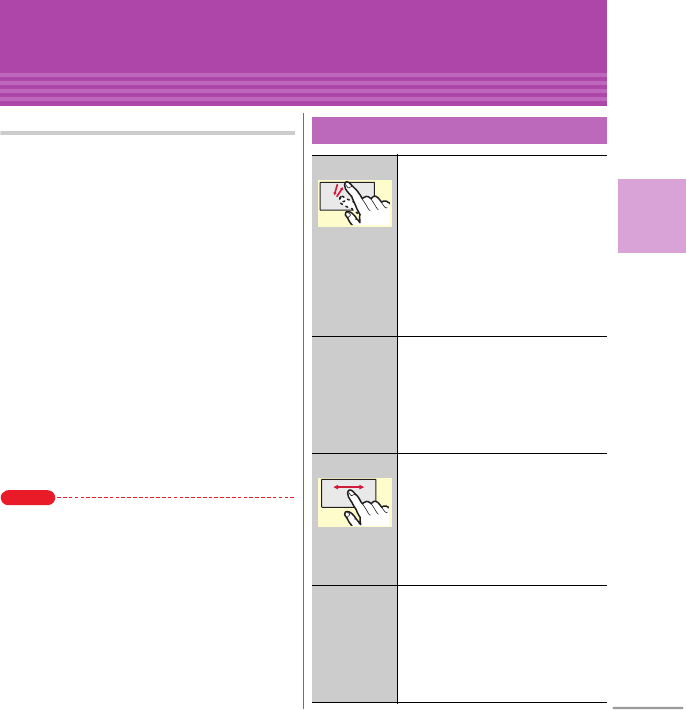
F-07C_EN_ninshou
25
Basic Operation
Screen Explanation
Using touch panel
Notes for using the touch panel
・
Do not apply excessive force when opening/
closing the FOMA terminal. Doing so may cause
malfunction or damage of the keys or the
display.
・
The touch panel is designed for being touched
lightly with fingers. Do not push it forcibly with
a finger or press it with sharp objects such as
nail, ballpoint pen, pin, etc.
・
Touching the touch panel may not work in the
following cases. Note that it may cause
malfunction.
- Operation with gloved hands
- Operation with tip of fingernail
- Operation with a foreign object on the display
- Operation with protective sheet or seal on the
display
- Operation with wet hand
・
Do not press forcibly the frame part around the
display. The touch panel may malfunction.
Point
・
Depending on the operation or function, effective
range for the touch operation may be different or
invalid.
Basic touch operation
Touch
Touch the display lightly once and
release the finger. The operation
becomes effective when you
release your finger from the
display. This operation is mainly
for selecting menus, items, etc.
To right-click in Windows 7 mode,
touch an icon etc. with one finger
and touch other part with other
finger. Alternatively, touch and
leave it for a while.
Double-
touch
Touch the display lightly twice and
release the finger. The operation
becomes effective when you
release your finger from the
display. This operation is mainly
for zooming in/out or switching
the display.
Slide
Keep touching the display, move
your finger up, down, left or right.
This operation is for rewinding/fast-
forwarding on MUSIC Player, Hand
writing input, switching tabs on the
phonebook list screen or pages.
This operation is unavailable in
Windows 7 mode.
Slide
quickly
Touch the display lightly and flick
your finger up, down, right or left.
This operation is for switching
pages or images, or moving to a
different chapter or tune, etc.
This operation is unavailable in
Windows 7 mode.
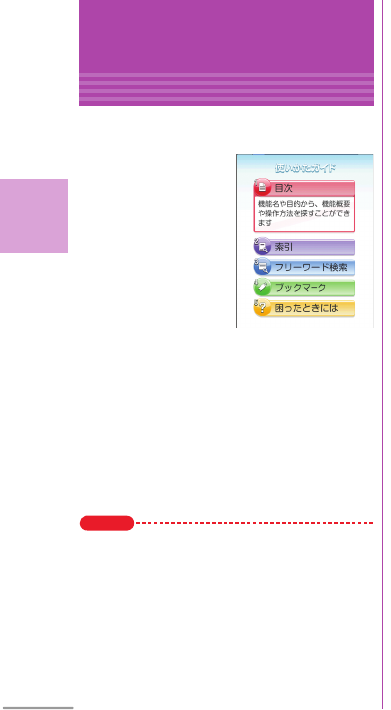
F-07C_EN_ninshou
26
Basic Operation
Screen Explanation
使いかたガイド
(Guide)
You can check overviews and operations of
functions, and troubleshooting. (In Japanese only)
amef
LifeKit
e*
Guide
e
Select
a search
method
目次 (Contents)
:
Search from a
list of
functions.
索引 (Index) :
Search from a
list of words
sorted according to Japanese syllabary.
フリーワード検索 (Free word search) :
Enter a keyword to search for.
ブックマーク (Bookmark) :
Search from a
list of registered bookmarks.
困ったときには (Troubleshooting) :
Search
from lists of troubles or error messages.
Point
・
On a description screen, select "
この機能を使う
(Use
this function)" to perform a function. Selecting a link
item in "
関連機能
(Related functions)", or "
→コチラ
(See more)" displays a corresponding description
screen.
<Guide screen>

F-07C_EN_ninshou
134
Others
Appendix
Specific absorption rate (SAR) of mobile phone
This model F-07C mobile phone complies with
Japanese technical regulations and international
guidelines regarding exposure to radio waves.
This mobile phone was designed in observance of
Japanese technical regulations regarding exposure to
radio waves (
*1
) and limits to exposure to radio waves
recommended by a set of equivalent international
guidelines. This set of international guidelines was set
out by the International Commission on Non-Ionizing
Radiation Protection (ICNIRP), which is in collaboration
with the World Health Organization (WHO), and the
permissible limits include a substantial safety margin
designed to assure the safety of all persons, regardless
of age and health condition.
The technical regulations and international guidelines
set out limits for radio waves as the Specific
Absorption Rate, or SAR, which is the value of
absorbed energy in any 10 grams of tissue over a 6-
minute period. The SAR limit for mobile phones is 2.0
W/kg. The highest SAR value for this mobile phone
when tested for use at the ear is 0.796 W/kg. There may
be slight differences between the SAR levels for each
product, but they all satisfy the limit.
The actual SAR of this mobile phone while operating
can be well below that indicated above. This is due to
automatic changes to the power level of the device to
ensure it only uses the minimum required to reach the
network. Therefore in general, the closer you are to a
base station, the lower the power output of the device.
This mobile phone can be used in positions other than
against your ear. This mobile phone satisfies the
international guidelines when used with a carrying
case or a wearable accessory approved by NTT
DOCOMO, INC.(
*2
)
In case you are not using the approved accessory ,
please use a product that does not contain any metals,
and one that positions the mobile phone at least 1.5 cm
away from your body.
The World Health Organization has stated that present
scientific information does not indicate that there are
harmful effects attributed to the use of mobile devices.
They recommend that if you are worried about your
exposure then you can limit your usage or simply use
a hands-free kit to keep the mobile device away from
the head and body.
Please refer to the WHO website if you would like more
detailed information.
http://www.who.int/docstore/peh-emf/publications/
facts_press/fact_english.htm
Please refer to the websites listed below if you would
like more detailed information regarding SAR.
Ministry of Internal Affairs and Communications
Website: http://www.tele.soumu.go.jp/e/sys/ele/
index.htm
Association of Radio Industries and Businesses
Website: http://www.arib-emf.org/index02.html (in
Japanese only)
NTT DOCOMO, INC. Website: http://
www.nttdocomo.co.jp/english/product/sar/
FUJITSU LIMITED Website: http://www.fmworld.net/
product/phone/sar/
*1
Technical regulations are defined by the Ministerial Ordinance
Related to Radio Law (Article 14-2 of Radio Equipment
Regulations).
*2
Regarding the method of measuring SAR when using mobile
phones in positions other than against the ear, international
standards (IEC62209-2) were set in March of 2010. On the
other hand, technical regulation is currently being deliberated
on by national council. (As of January, 2011)
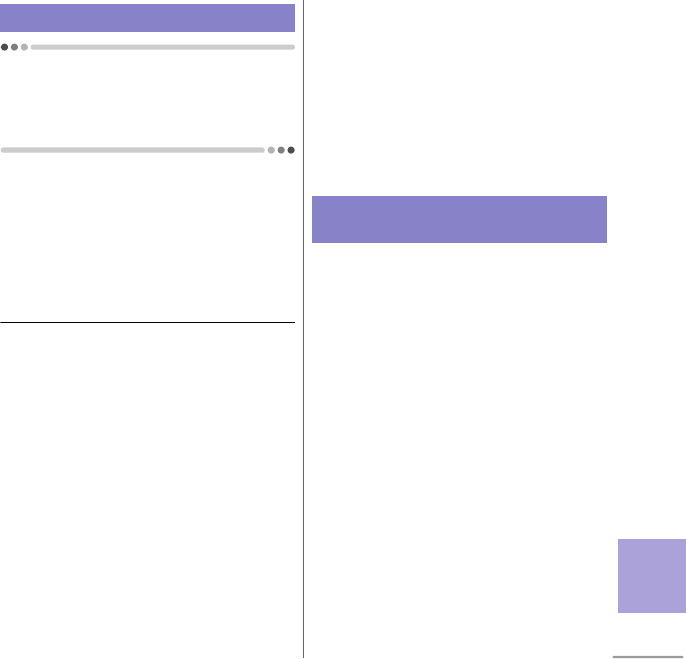
F-07C_EN_ninshou
135
Others
The product "F-07C" is declared to conform with the
essential requirements of European Union Directive
1999/5/EC Radio and Telecommunications Terminal
Equipment Directive 3.1(a), 3.1(b) and 3.2. The
Declaration of Conformity can be found on http://
www.fmworld.net/product/phone/doc/.
This mobile phone complies with the EU requirements
for exposure to radio waves.
Your mobile phone is a radio transceiver, designed and
manufactured not to exceed the SAR
*
limits
**
for
exposure to radio-frequency(RF) energy, which SAR
*
value, when tested for compliance against the
standard was 0.944W/kg. While there may be
differences between the SAR
*
levels of various phones
and at various positions, they all meet
***
the EU
requirements for RF exposure.
* The exposure standard for mobile phones
employs a unit of measurement known as the
Specific Absorption Rate, or SAR.
** The SAR limit for mobile phones used by the
public is 2.0 watts/kilogram (W/Kg) averaged over
ten grams of tissue, recommended by The
Council of the European Union. The limit
incorporates a substantial margin of safety to
give additional protection for the public and to
account for any variations in measurements.
*** Tests for SAR have been conducted using
standard operation positions with the phone
transmitting at its highest certified power level in
all tested frequency bands. Although the SAR is
determined at the highest certified power level,
the actual SAR level of the phone while operating
can be well below the maximum value. This is
because the phone is designed to operate at
multiple power levels so as to use only the power
required to reach the network. In general, the
closer you are to a base station antenna, the
lower the power output.
・
This device complies with part 15 of the FCC rules.
Operation is subject to the following two conditions :
a
this device may not cause harmful interference,
and
b
this device must accept any interference received,
including interference that may cause undesired
operation.
・
Changes or modifications made in or to the radio
phone, not expressly approved by the manufacturer,
will void the user's authority to operate the
equipment.
Declaration of Conformity
Federal Communications
Commission (FCC) Notice

F-07C_EN_ninshou
136
Others
This model phone meets the U.S. Government's
requirements for exposure to radio waves.
This model phone contains a radio transmitter and
receiver. This model phone is designed and
manufactured not to exceed the emission limits for
exposure to radio frequency (RF) energy as set by the
FCC of the U.S. Government. These limits are part of
comprehensive guidelines and establish permitted
levels of RF energy for the general population. The
guidelines are based on standards that were
developed by independent scientific organizations
through periodic and thorough evaluation of scientific
studies.
The exposure standard for wireless mobile phones
employs a unit of measurement known as the Specific
Absorption Rate (SAR). The SAR limit set by the FCC is
1.6 W/kg. Tests for SAR are conducted using standard
operating positions as accepted by the FCC with the
phone transmitting at its highest certified power level
in all tested frequency bands. Although the SAR is
determined at the highest certified power level, the
actual SAR level of the phone while operating can be
well below the maximum value. This is because the
phone is designed to operate at multiple power levels
so as to use only the power required to reach the
network. In general, the closer you are to a wireless
base station antenna, the lower the power output level
of the phone.
Before a phone model is available for sale to the public,
it must be tested and certified to prove to the FCC that
it does not exceed the limit established by the U.S.
government-adopted requirement for safe exposure.
The tests are performed on position and locations (for
example, at the ear and worn on the body) as required
by FCC for each model. The highest SAR value for this
model phone as reported to the FCC, when tested for
use at the ear, is 0.730W/kg, and when worn on the
body, is 0.521W/kg. (Body-worn measurements differ
among phone models, depending upon available
accessories and FCC requirements).
While there may be differences between the SAR levels
of various phones and at various positions, they all
meet the U.S. government requirements.
The FCC has granted an Equipment Authorization for this
model phone with all reported SAR levels evaluated as in
compliance with the FCC RF exposure guidelines. SAR
information on this model phone is on file with the FCC
and can be found under the Equipment Authorization
Search section at http://www.fcc.gov/oet/ea/fccid/ (please
search on FCC ID VQK-F07C).
For body worn operation, this phone has been tested
and meets the FCC RF exposure guidelines when used
with an accessory designated for this product or when
used with an accessory that contains no metal and
which positions the handset at a minimum distance of
1.5 cm from the body.
*
In the United States, the SAR limit for wireless mobile phones
used by the general public is 1.6 Watts/kg (W/kg), averaged
over one gram of tissue. SAR values may vary depending upon
national reporting requirements and the network band.
This equipment has been tested and found to comply
with the limits for a Class B digital device, pursuant to
part 15 of the FCC Rules.
These limits are designed to provide reasonable
protection against harmful interference in a residential
installation. This equipment generates, uses and can
radiate radio frequency energy and, if not installed and
used in accordance with the instructions, may cause
harmful interference to radio communications.
However, there is no guarantee that interference will
not occur in a particular installation.
If this equipment does cause harmful interference to
radio or television reception, which can be determined
by turning the equipment off and on, the user is
encouraged to try to correct the interference by one or
more of the following measures:
- Reorient or relocate the receiving antenna.
- Increase the separation between the equipment
and receiver.
-
Connect the equipment into an outlet on a circuit
different from that to which the receiver is connected.
- Consult the dealer or an experienced radio/TV
technician for help.
FCC RF Exposure Information

F-07C_EN_ninshou
137
Others
AIRCRAFT
Switch off your wireless device when boarding an
aircraft or whenever you are instructed to do so by
airline staff. If your device offers flight mode or similar
feature consult airline staff as to whether it can be used
on board.
DRIVING
Full attention should be given to driving at all times
and local laws and regulations restricting the use of
wireless devices while driving must be observed.
HOSPITALS
Mobile phones should be switched off wherever you
are requested to do so in hospitals, clinics or health
care facilities. These requests are designed to prevent
possible interference with sensitive medical
equipment.
PETROL STATIONS
Obey all posted signs with respect to the use of
wireless devices or other radio equipment in locations
with flammable material and chemicals. Switch off
your wireless device whenever you are instructed to do
so by authorized staff.
INTERFERENCE
Care must be taken when using the phone in close
proximity to personal medical devices, such as
pacemakers and hearing aids.
Pacemakers
Pacemaker manufacturers recommend that a
minimum separation of 15 cm be maintained between
a mobile phone and a pace maker to avoid potential
interference with the pacemaker. To achieve this use
the phone on the opposite ear to your pacemaker and
does not carry it in a breast pocket.
Hearing Aids
Some digital wireless phones may interfere with some
hearing aids. In the event of such interference, you
may want to consult your hearing aid manufacturer to
discuss alternatives.
For other Medical Devices :
Please consult your physician and the device
manufacturer to determine if operation of your phone
may interfere with the operation of your medical
device.
Important Safety Information
Appendix
Export Administration Regulations
This product and its accessories may be under
coverage of the Export Administration
Regulations of Japan ("Foreign Exchange and
Foreign Trade Control Laws" and the related laws
and regulations). And, they are also under
coverage of Export Administration Regulations of
the U.S. When exporting and reexporting this
product and its accessories, take necessary
procedures on your responsibility and expense.
For details, contact Ministry of Economy, Trade
and Industry of Japan or US Department of
Commerce.
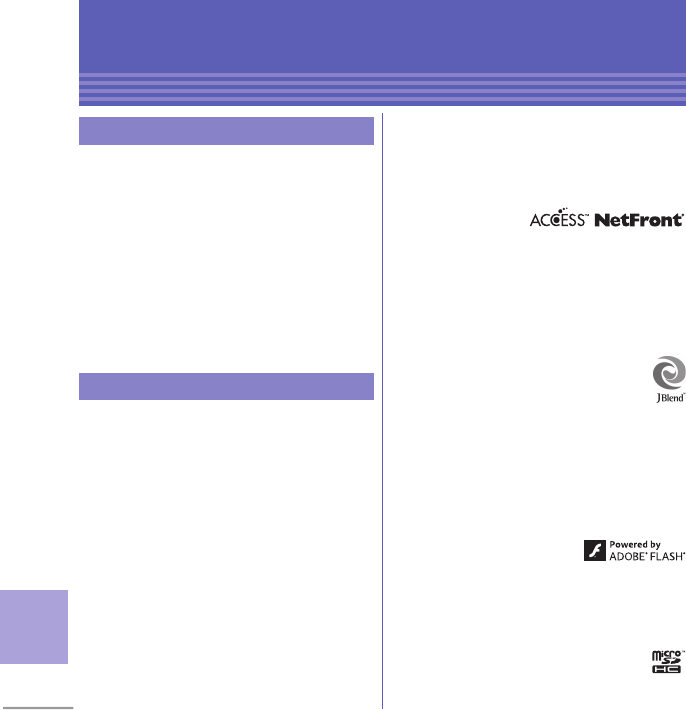
F-07C_EN_ninshou
138
Others
Appendix
Intellectual Property Right
Except for the case protected by copyright laws such as
personal use, use of FOMA terminal to reproduce,
alter, or publicly transmit recorded pictures or sounds,
or copyrighted text, images, music or software
downloaded from websites without the copyright
holder's authorization is prohibited.
Note that taking photos or recordings at some
demonstrations, performances or exhibitions may be
prohibited even when only for personal use.
Avoid taking pictures of others with FOMA terminal
without their consent or disclosing recorded pictures
of others without their consent to general public
through Internet websites etc., because they may
infringe on portrait rights.
Company and product names mentioned in this
manual are trademarks or registered trademarks of
their respective holders.
・
"FOMA", "i-motion", "i-mode", "i-
α
ppli", "mopera",
"WORLD CALL", "WORLD WING", "Deco-mail",
"Chara-den", "ToruCa", "2in1", "DCMX", "i-area",
"OFFICEED", "docomo PRO series" and logos of
"FOMA", "i-mode", "i-
α
ppli", "Music&Video
Channel", "iC" are trademarks or registered
trademarks of NTT DOCOMO.
・
Microsoft, Windows, Windows Live, Internet
Explorer, Silverlight, Excel and Outlook are
trademarks of Microsoft Corporation and/or its
subsidiaries in Japan.
・
"Multitask" is a registered trademark of NEC
Corporation.
・
"Catch Phone (Call Waiting Service)" is a registered
trademark of Nippon Telegraph and Telephone
Corporation.
・
Java and all Java-related trademarks and logos are
trademarks or registered trademarks of Sun
Microsystems, Inc. in the US and other countries.
・
This product
contains NetFront
Browser, NetFront
Sync Client of ACCESS CO., LTD.
ACCESS, the ACCESS logo and NetFront are
registered trademarks or trademarks of ACCESS
CO., LTD. in the United States, Japan and/or other
countries.
Copyright
©
2010 ACCESS CO., LTD. All rights
reserved.
・
Powered by JBlend
™
Copyright 2002-2010
Aplix Corporation. All rights reserved.
JBlend and JBlend-related trademarks are
trademarks or registered trademarks of
Aplix Corporation in Japan and other countries.
・
This product contains Adobe
®
Flash
®
Lite
®
and
Adobe Reader
®
LE technology of Adobe Systems
Incorporated.
Adobe Flash Lite Copyright
©
2003-2010 Adobe
Systems Incorporated. All rights reserved.
Adobe Reader Mobile Copyright
©
1993-2010 Adobe
Systems Incorporated. All rights reserved.
Adobe, Adobe Reader, Flash
and Flash Lite are either
registered trademarks or
trademarks of Adobe Systems Incorporated in the
United States and/or other countries.
・
QR code is a registered trademark of Denso Wave
Inc.
・
microSDHC Logo is a trademark of SD-3C,
LLC.
Copyrights and portrait rights
Trademarks
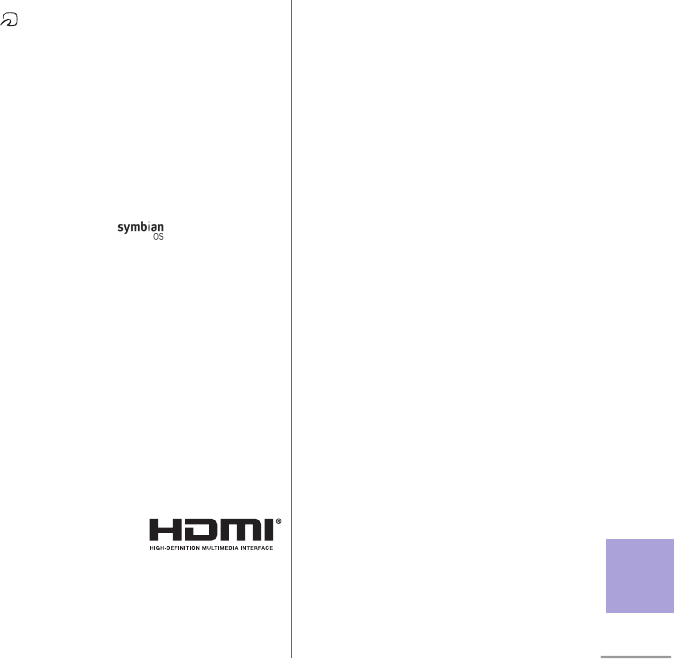
F-07C_EN_ninshou
139
Others
・
FeliCa is a registered trademark of Sony Corporation.
・
is a registered trademark of FeliCa Networks, Inc.
・
McAfee
®
is registered trademarks or trademarks of
McAfee, Inc. and/or its affiliates in the US and/or
other countries.
・
QuickTime is a registered trademark of Apple Inc. in
the US and other countries.
・
ATOK + APOT of Justsystem Corporation is installed
in this product as Japanese character conversion
function.
"ATOK" "APOT (Advanced Prediction Optimization
Technology)" are registered trademarks of
Justsystem Corporation.
・
This equipment is provided with the software
licensed by Symbian Software Ltd. or the
licensor
©
1998-2010. and Symbian OS are
trademarks of Symbian Ltd. or the licensor.
・
"Privacy mode" is a registered trademark of FUJITSU
LIMITED.
・
Bluetooth
®
and its logo are registered trademarks of
Bluetooth SIG, Inc., and NTT DOCOMO uses them
under license. Other trademarks and names inhere
to their respective owners.
・
"
丸ゴシック
(Maru Gothic)", "
レイミン
(Reimin)" and
"
丸フォーク
(Maru Fork)" are provided by Morisawa
& Company, Ltd. and the copyrights of these font
data belong to them. Names of "
レイミン
(Reimin)"
and "
丸フォーク
(Maru Fork)" are their trademarks.
・
Google, Google calendar and Google Map for Mobile
are trademarks of Google Inc.
・
Wi-Fi
®
, Wi-Fi Alliance
®
, and logos of Wi-Fi and Wi-Fi
CERTIFIED are registered trademarks of Wi-Fi
Alliance.
・
Blu-ray Disc and its logo are trademarks.
・
HDMI, HDMI logo and
High-Definition
Multimedia Interface are
trademarks and
registered trademarks of HDMI Licensing, LLC.
・
@nifty is a trademark of NIFTY Corporation.
・
Facebook is a registered trademark of Facebook, Inc.
in the United States and other countries.
・
Twitter is a registered trademark of Twitter, Inc in the
United States or other countries.
・
Other company and product names mentioned in
this manual are trademarks or registered trademarks
of their respective holders.
・
The abbreviations of operating systems (Japanese
versions) below are used in this manual.
- Windows 7 indicates Windows
®
7 operating
system, Windows
®
7 Starter, Home Basic, Home
Premium, Professional, or Enterprise Ultimate.
- Windows Vista indicates Windows Vista
®
operating system, Windows Vista
®
Home Basic,
Home Premium, Business, Enterprise or Ultimate.
- Windows XP indicates Windows
®
XP operating
system or Windows
®
XP Home Edition,
Professional, Tablet PC Edition or Media Center
Edition.
- Windows 2000 indicates Windows
®
2000 operating
system or Windows
®
2000 Professional.

F-07C_EN_ninshou
140
Others
・
FeliCa is a contactless IC card technology developed
by Sony Corporation.
・
This product contains a module developed by the
Independent JPEG Group.
・
This product is equipped with the technologies of
GestureTek, Inc.
Copyright
©
2006-2010, GestureTek, Inc. All Rights
Reserved.
・
"
学研モバイル国語辞典
(Gakken Mobile JpnDic)", "
学
研モバイル和英辞典
(Gakken Mobile JE Dic)", "
学研モ
バイル英和辞典
(Gakken Mobile EJ Dic)", "
今日は何の
日
(Today's trivia)" and "
今日の歴史
(Today in
history)" are copyrighted by GAKKEN CO., LTD.
・
This product is licensed based on MPEG-4 Visual
Patent Portfolio License. The use of MPEG-4 Video
Codec function is allowed for personal and nonprofit
use only in the cases below.
- Recording moving pictures and i-motion that
conform to MPEG-4 Visual Standard (hereinafter
referred to as MPEG-4 Video)
- Playing MPEG-4 Videos recorded personally by
consumers not engaged in profit activities
- Playing MPEG-4 Video supplied from the provider
licensed from MPEG-LA
For further utilizing such as promotion, in-house
use or profit-making business, please contact
MPEG LA, LLC in U.S.
・
Content owners use Windows Media digital rights
management technology (WMDRM) to protect their
intellectual property, including copyrights. This
device uses WMDRM software to access WMDRM-
protected content. If the WMDRM software fails to
protect the content, content owners may ask
Microsoft to revoke the software's ability to use
WMDRM to play or copy protected content.
Revocation does not affect unprotected content.
When downloading licenses for protected content,
you agree that Microsoft may include a "Revocation
List" with the licenses. Content owners may require
you to upgrade WMDRM to access their content. If
you decline an upgrade, you cannot access a content
that requires the upgrade.
Others
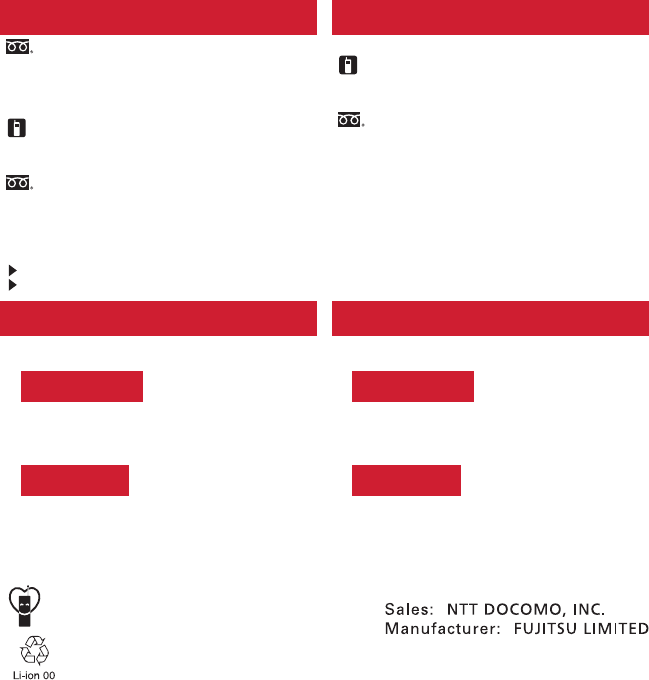
International call access code
for the country you stay
Repairs
General Inquiries
<docomo Information Center>
Failures encountered overseas
<Network Support and Operation Center>
Loss or theft of FOMA terminal or payment of cumulative cost overseas
<docomo Information Center>
* Service available in: English, Portuguese, Chinese, Spanish, Korean.
* Unavailable from part of IP phones.
(Business hours : 9:00 a.m. to 8:00 p.m. (open all year round))
0120-005-250 (toll free)
(Business hours : 9:00 a.m. to 8:00 p.m.)
* Unavailable from part of IP phones.
■
From land-line phones (In Japanese only)
0120-800-000 (toll free)
* Unavailable from land-line phones, etc.
(No prefix) 151 (toll free)
■
From DOCOMO mobile phones (In Japanese only)
●
Please confirm the phone number before you dial.
●
For Applications or Repairs and After-Sales Service, please contact the above-mentioned information center or the docomo
shop etc. near you on the NTT DOCOMO website or the i-mode site.
(available 24 hours a day)
* You are charged a call fee to Japan when calling from a land-line phone, etc.
※
If you use F-07C, you should dial the number 㧗81-3-6832-6600
(to enter '㧗', press and hold the '0' key for at least one second).
* You are charged a call fee to Japan when calling from a land-line phone, etc.
※
If you use F-07C, you should dial the number 㧗81-3-6718-1414
(to enter '㧗', press and hold the '0' key for at least one second).
■
From land-line phones <Universal number>
●
If you lose your FOMA terminal or have it stolen, immediately take the steps necessary for suspending the use of the FOMA terminal.
●
If the FOMA terminal you purchased is damaged, bring your FOMA terminal to a repair counter specified by DOCOMO after returning to Japan.
* You might be charged a domestic call fee according to the call rate for the country
you stay.
※
For international call access codes for major countries and universal number
international prefix, refer to DOCOMO International Services website.
Universal number
international prefix -8000120-0151
*
CA92002-6362
2011.5 (1st Edition)
To prevent damage to the environment, bring
used battery packs to a docomo service counter,
a docomo agent or a recycle center.
-81-3-6832-6600
*
(toll free)
(Business hours : 24 hours (open all year round))
* Unavailable from part of IP phones.
■
From land-line phones (In Japanese only)
0120-800-000 (toll free)
* Unavailable from land-line phones, etc.
(No prefix) 113 (toll free)
■
From DOCOMO mobile phones (In Japanese only)
■
From land-line phones <Universal number>
* You might be charged a domestic call fee according to the call rate for the country
you stay.
※
For international call access codes for major countries and universal number
international prefix, refer to DOCOMO International Services website.
Universal number
international prefix -8005931-8600
*
NTT DOCOMO website http://www.nttdocomo.co.jp/english/
■
From DOCOMO mobile phones
i-mode site iMenu
⇒お客様サポート
(user support)
⇒ドコモショップ
(docomo Shop) * In Japanese only
International call access code
for the country you stay
(available 24 hours a day)
-81-3-6718-1414
*
(toll free)
■
From DOCOMO mobile phones
Don't forget your mobile phone ・・・ or your manners!
When using your mobile phone in a public place, don't forget to
show common courtesy and consideration for others around you.